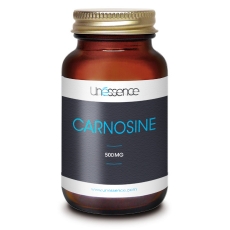No products
Product successfully added to your shopping cart
There are 0 items in your cart. There is 1 item in your cart.
 View larger
View larger
Carnosine
500 MG
Amino acid
Carnosine is a peptide with powerful antioxidant properties. Carnosine protects cells against :
-
oxidation of cells due to "Maillard reactions" or cross-linking of proteins
-
the regular aggression of sugars due to glycation
-
acidosis of the body's cells
Carnosine enables the production of stem cells that are essential for cell renewal. Carnosine protects from the particularly harmful action of sugars on the fragile proteins that make up many organs, even if there is no problem with blood sugar levels.
Carnosine prevents the oxidation and degradation (glycation) of proteins in the body. It has a special protective effect on the eye. The proteins most likely to be severely damaged by glycation are :
-
Collagen: major constituent of the skin and joints, structural and filling protein.
-
Elastin: constituent of blood vessels and ligaments.
-
Keratin: constituent of skin, hair and nails.
-
Myosin: muscle tissue
-
Hemoglobin: protein that transports red blood cells and oxygen throughout the body.
-
Insulin: controls blood sugar levels and provides fuel for all cells in the body.
Carnosine and anti-aging action (telomeres and stem cells)
Carnosine exerts a real anti-ageing action by acting on two distinct mechanisms:
-
direct action on telomeres
-
stem cell stimulation
The last decade has been marked by significant scientific research dedicated to the action of telomeres. Telomeres are repetitive DNA sequences in the form of small protective caps located at the ends of chromosomes. Each cell division will initiate and provoke telomere shortening and the cell's potential for replication. This degradation will lead to a slowing of the cell cycle, premature wear and tear, loss of function and death of the cell. Scientific research tells us that the length of the telomeres determines the longevity of the cells and the organism.
Numerous scientific studies carried out in particular on human fibroblasts tell us that carnosine :
-
significantly slows down the shortening of the telomeres of the cells.
-
prolongs cell life
-
allows less damage to accumulate in the DNA of the telomeres.
Biochem Biophys Res Commun 2004
Carnosine and protection of the mitochondria or power plant
Carnosine works because it acts within a very specific structure of the cell: the mitochondrion.
This one, a real energy stack, makes the fuel for each cell of the organism. It is the seat of an important activity with a high consumption of oxygen. This leads to a strong oxidation.
This function is paradoxical because the structure of the cell responsible for protecting the cell from oxidation is itself the site of strong oxidation. Indeed, the primary function of the mitochondria inevitably leads to the production of free radicals and is the primary source of damage and wear to the cell.
The presence of carnosine in the mitochondria is the result of an adaptation process designed to avoid oxidation and the production of free radicals. Carnosine regulates aggression and mutation of mitochondrial DNA.
Antioxidant activity
Carnosine has a special anti-oxidant and cell-protecting activity:
-
inhibition of the production of oxygen free radicals
-
Neutralization and suppression of superoxide radicals, hydroxyl radicals and reactive aldehydes
-
suppression of protein glycation or cross-linking of proteins (Maillard reaction) on many organs
Carnosine and loss of supporting tissue
Degradation of support tissue and loss of muscle tissue are real markers of wear, insufficient renewal and aging. The loss of muscle with age is explained by glycation, a phenomenon that results in an attack and then a degradation of muscle cell proteins by sugars.
Tissue acidosis occurs, resulting in a true asphyxiation of the cells. The acid waste cannot be properly eliminated and the energy fuel can only be produced again after toxic waste (lactic acid, ammonia, etc.) has been removed.
Carnosine has a "buffer" function on acids, protons and lactic acids produced by muscular exercise, a tense, stressed, devitalized organism or/and a polluted and under-oxygenated environment.
Carnosine stops the degradation of the proteins that structure our tissues, including muscle tissue and other organs, and allows their renewal through the manufacture of stem cells. It stops the acidosis of the body and the acidity of cells and tissues. It regulates the pH of tissues and protects DNA from iron damage.
Functions of Carnosine
-
Protection of neurons and the vascular network from oxygen deficiency
-
Stimulation of the production of stem cells (pluripotent cells) from bone marrow
-
Decreased death and increased survival of stem cells
-
Decrease in the oxidation of brain lipids
-
Decrease in necrosis and apoptosis of neurons
-
Decreased dysfunction of brain cell mitochondria
Brain functions, carnosine and olfactory system
Carnosine plays a very important role in olfaction. The olfactory system is an integral part of the region of the brain that is particularly involved in memory processes.
The olfactory lobe is very rich in Carnosine and zinc. The loss of olfaction is an early sign of cognitive disturbances. Numerous scientific studies have shown the effectiveness of Carnosine in breaking down the Beta amyloid protein, one of the causal agents of age-related cognitive disorders.
| Supplements facts | Serving Size : 6 capsules: Carnosine 3000 mg, Vegetal capsule (HPMC) |
| Suggested use | Adults, as a dietary supplément take 1 or 2 capsules before the 3 meals |
| Quantity | 60 |
| Weight | 35,4 g |


